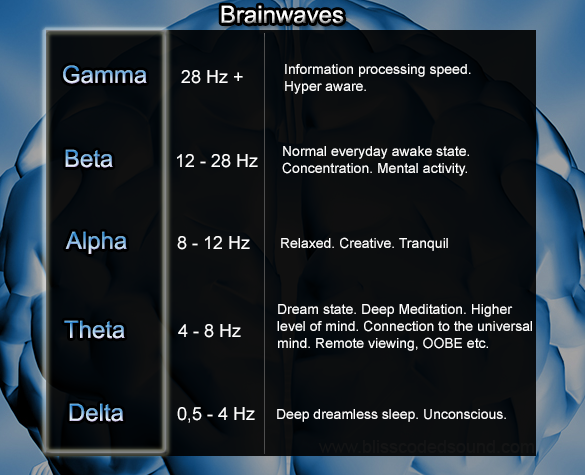Brainwave Entrainment and Brainwaves
The brain produces electrical signals. These signals change depending on what we are doing and what mental state we are in. For instance when we sleep these signals are different from when we are awake. This electrical brain activity can be meassured with EEG (Electroencephalography). It will output in Hz (Hertz, which is cycles per second) these electrical signals, showing within the spectrum of brainwaves the brain produces, where the highs and lows are. We get a "map" of the brain activity. The most dominant brainwaves will tell us what sort of state a person is in. The slower vibration (lower Hz), the more relaxed that individual is. It should be mentioned that the brain always outputs a wide spectrum of brainwave acivity. It is not just one frequency at a time. As an example some Buddhist monks experienced in mediation will show a simultaneous peak of Theta and Gamma frequencies, showing that they are highly aware even in a state where most simply fall asleep.

Brainwave chart
These brainwaves are divided into 5 categories:
- Gamma
The highest end of the spectrum. Gamma waves display a high brain processing speed. It can signify someone who is hyper alert and has been connected to intelligence.
- Beta
Our normal daytime state. Focused, alert, attention, focus etc. An unwanted lack of Beta brainwaves is often experienced as fatigue and is also often found in those experiencing anxiety, in which case if there is nothing physically wrong, using Beta brainwave entrainment has often been shown to help. With anxiety, a mix of Alpha and Beta has been shown effective.
- Alpha
Relaxed, creative, tranquil, memory improvement, well-being. This is a very enjoyable restful state for the most part. Alpha brainwaves is linked with increased creativity and helps with problem solving. When we are active all day in the Beta state and then relax at the end of the day after getting home or going somewhere else to just relax, often we will suddenly think of a solution to a problem or creative idea solving a problem we may have been working on earlier during the day when we were not relaxed.
- Theta
We all pass through this state when falling asleep every night. Some call it the sleep state, but that is not entirely correct. In meditation when going even deeper than the relaxed alpha state, we enter into the Theta state. It is very easy to fall asleep from here, but if you have had a dream in which you were awake within the dream, then only your body was sleeping. Meditators by practise learn to enter this state at will and will experience existing in the non physical reality within where the connection to the universal mind allows them to gain insights and knowledge as well as remote viewing, traveling etc. With much practise it is possible to remain in the Theta state even during our everyday lives.
- Delta
Deep unconscious dreamless sleep. Deeply rejuvenating for the body which is why it is important to get enough deep sleep. In a test done in 1985 by Solomon GD, it was shown that 14 out of 15 headaches went away with the use of Delta brainwave entrainment. Even though Delta is associated with sleep, just like with the other ranges in the brainwave spectrum, you can have active Delta brainwaves during your normal awake everyday state as sort of a background.

How brainwave entrainment works
Let us say you want to relax in to an Alpha state and decide to stimulate the 10 Hz brainwave frequency. Do not confuse the brainwave Hz with the Hz used to describe the pitch of a musical note. In brainwave entrainment, Hz (Hertz) is used to specify the pulses per second of the electric signals within the brain. A 10 Hz musical tone can not even be heard since the human ear only picks up from about 20Hz to 20.000 Hz (20 Khz).
What you do is to use headphones and play one steady tone is the left ear at lets say 400 Hz (a real tone), and in the right ear a tone at 410Hz. What will happen now is that these two tones together creates one pulsing tone sounding to you like it comes from the middle of your head, just between your ears. The brain will enterpret this tone to be in the exact middle of the two tones played (405 Hz), and the difference between the two tones (410Hz - 400Hz = 10Hz) will make the 405 Hz tone "pulsate" at a speed of 10 Hz (10 pulses per second). See, this pulsating 405 Hz tone only exists in your brain, but it is real. It is being created by the brain and what will happen is that the 10 Hz pulsation increases the brainwave activity at 10 Hz in your brain. As the 10 Hz brainwave frequency increases in aplitude in the brain's electrical signals you will begin feeling more relaxed and if someone did a EEG test on you after a couple of minutes you would see that you have an increased amplitude of the 10 Hz Alpha brainwave frequency. This type of brainwave entrainment is called binaural beats.
Author: Marcus Knudsen - http://www.blisscodedsound.com
You are free to use this article as long as you post it in its entirety and include the author and website link (Marcus Knudsen - https://blisscodedsound.com/)
Copyright © BlissCodedSound.com. All Rights Reserved.
